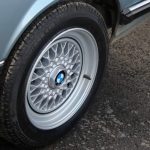Through the gloom of the June dawn, the two cars fought for position. Up, under the Dunlop Bridge then down, through the Esses they remained nose to tail. The big Corvette with its 4.6 litre V8 couldn’t compete with the Ferrari V12 in a straight fight, but the rain had added another dimension that favoured the American car. With its twin headlamps shining though the half-light, the Corvette kept the race-bred Ferrari at bay- around Tetre Rouge, along the Mulsanne Straight, then round Indy, through Arnarge and back past Maison Blanche to the start/finish straight.
The year was 1960, and the Corvette was making its debut at the 24 Hours of Le Mans. Although the Ferrari 250 Testarossa finally triumphed, the three Corvette production cars, adapted for the track by legendary racer Briggs Cunningham, performed better than anyone expected. By the end of the race two Corvettes were among the 25 finishers, and car #3 had achieved a class win and 8th place overall.

In 2015, with more than five decades of racing history now behind them, Corvette Racing once again won the GTE Pro Class at Le Mans, with veteran British driver Oliver Gavin winning his fifth title for the team in the iconic 24 hour race.
The cars and mechanical preparation of these two Corvette teams, separated by 55 years, couldn’t have been more different. Back in 1960, Cunningham shipped his three Corvettes over the Atlantic, landing at the port of Le Havre. They were standard production cars- although fitted with useful options for a 24 hour race, such as a hard top, windscreen wipers and a “radio delete”. Race preparation then took place: Koni shocks, Halibrand wheels and aircraft jump-seats were added, plus a ‘Sebring’ exhaust and 37-gallon fuel tank. Just before the race, cast-iron heads with big valves and improved porting were added.
This year the Corvette Racing cars have a different background. The Corvette C7.R is based on the road-going C7, but this is a pure-bred racing car. With an aluminium monocoque chassis, the C7.R has a Chevrolet 5.5 litre V8 engine that produces 491hp through a six-speed semi-automatic gearbox.
But despite the differences, the legendary endurance race hit both teams with problems that they didn’t expect. Cunningham’s #1 car crashed three hours into the race during a heavy rainstorm. The #2 car lasted longer, and even survived a spin into a sand-trap, but the stressed engine finally gave up after 20 hours.
This year, Corvette Racing’s #63 car had a big accident at the Porsche Curves when debris became wedged in the accelerator pedal box. With the throttle wedged open, driver Jan Magnussen was unable to control the car and the car left the road. Although he was unhurt, the chassis was damaged beyond repair and the car was withdrawn from the race.
So in 2015, as in 1960, only one team Corvette was left to contend for the crown. In 1960, Cunningham’s #3 car suffered from overheating toward the latter stages of the race. With rules restricting when coolant could be added, the team came up with the unusual idea of packing dry ice on the engine. Suitable cooled, the car limped across the line, winning the big-bore GT class.
This year, #63 Corvette had no mechanical problems, but was involved in an epic battle for the lead with the #51 Ferrari 458 Italia of AF Corse. Even after 18 hours of racing the two cars were still nose to tail, but then a gearbox issue handed the lead permanently to the big yellow Corvette, winning with 337 laps completed in the 24 hour session.
After the 1960 race, the three Corvettes were shipped back to the United States, where they were returned to something akin to street specification and sold. Despite being lost for many years, the location of all three is now known, and the successful #3 car (restored to its race specification) is often seen at events.
So what’s next for Corvette Racing? We can only hope there’s another 55 years in the tank.
A film of the 1960 Briggs Cunningham Corvette team at Le Mans is here: https://www.youtube.com/watch?v=aGCGz6rAEts












